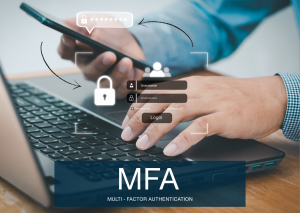Published date:

Cyber Security Awareness Month 2025
The advice to "enable Multi-Factor Authentication (MFA)" may sound familiar even repetitive, it is time to explore the concept more deeply. In today’s evolving threat landscape, MFA is not merely a recommendation it is a fundamental part of a secure digital environment.
A New Approach: Trust Nothing, Verify Everything!
Historically, cyber security operated like a fortress: build strong defences, secure the perimeter, and monitor the gate. However, with the rise of remote working, cloud-based services, and increasingly sophisticated phishing attacks, this model is no longer sufficient. The Zero Trust approach has emerged in response, built on the principle that no user or device should be trusted by default.
Zero Trust requires that:
Every access request is treated as potentially malicious
Identity, device health, location, and behaviour are verified continuously
MFA plays a critical role not only at login, but throughout the user session
Not All MFA Is Equally Secure
If your organisation still relies on text message-based MFA, it may be time to reconsider. According to the National Cyber Security Centre (NCSC), SMS-based authentication is vulnerable to phishing and SIM-swapping attacks. More secure alternatives include:
Authenticator applications such as Microsoft Authenticator or Google Authenticator
Biometric authentication, including fingerprint or facial recognition
Hardware security keys like YubiKey or Titan
These methods offer phishing resistant MFA, which is increasingly vital in an environment where attackers exploit human behaviour rather than technical flaws. Even if someone steals your password, they still can’t get into your account without that second step!
MFA Is the First Line of Defence for Identity Protection
Cyber criminals often do not break in instead they log in. Stolen credentials remain one of the leading causes of data breaches. MFA introduces an additional layer of verification, making it significantly more difficult for attackers to gain unauthorised access.
MFA as part of a broader security strategy
Cyber security is not defined by a single tool; it is a culture. MFA is one of its most impactful habits. MFA is most effective when integrated into a comprehensive cyber security framework. It should be combined with:
Strong passwords or passphrases
Regular software and device updates
User education on phishing and social engineering
This October, Make MFA Meaningful
Cyber Awareness Month is an opportunity to move beyond surface-level advice. Rather than simply encouraging users to enable MFA, organisations should explain why it matters, how to implement it securely, and what risks are mitigated by doing so. Let us shift from awareness to action. In a Zero Trust world, trust must be earned, and MFA is where that process begins.
Read more information at NCSC - Authenticate and authorise everywhere - NCSC.GOV.UK